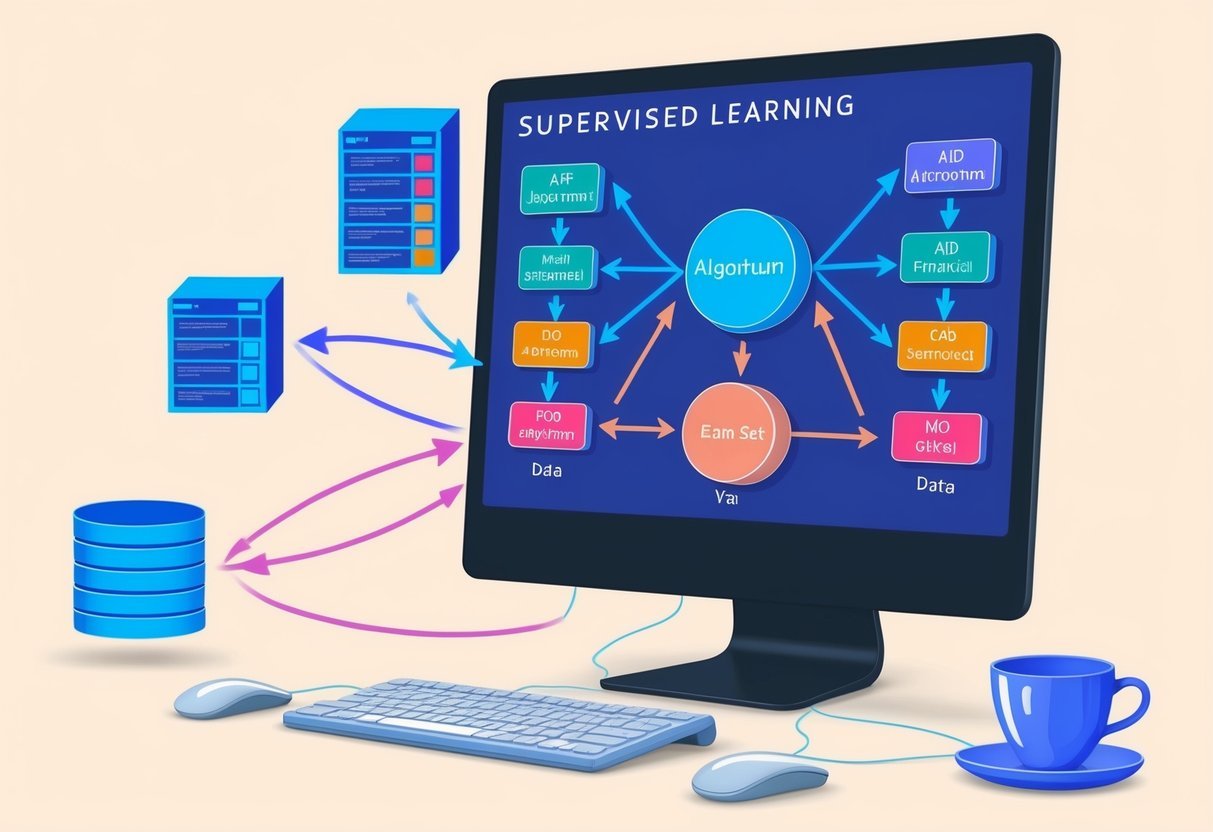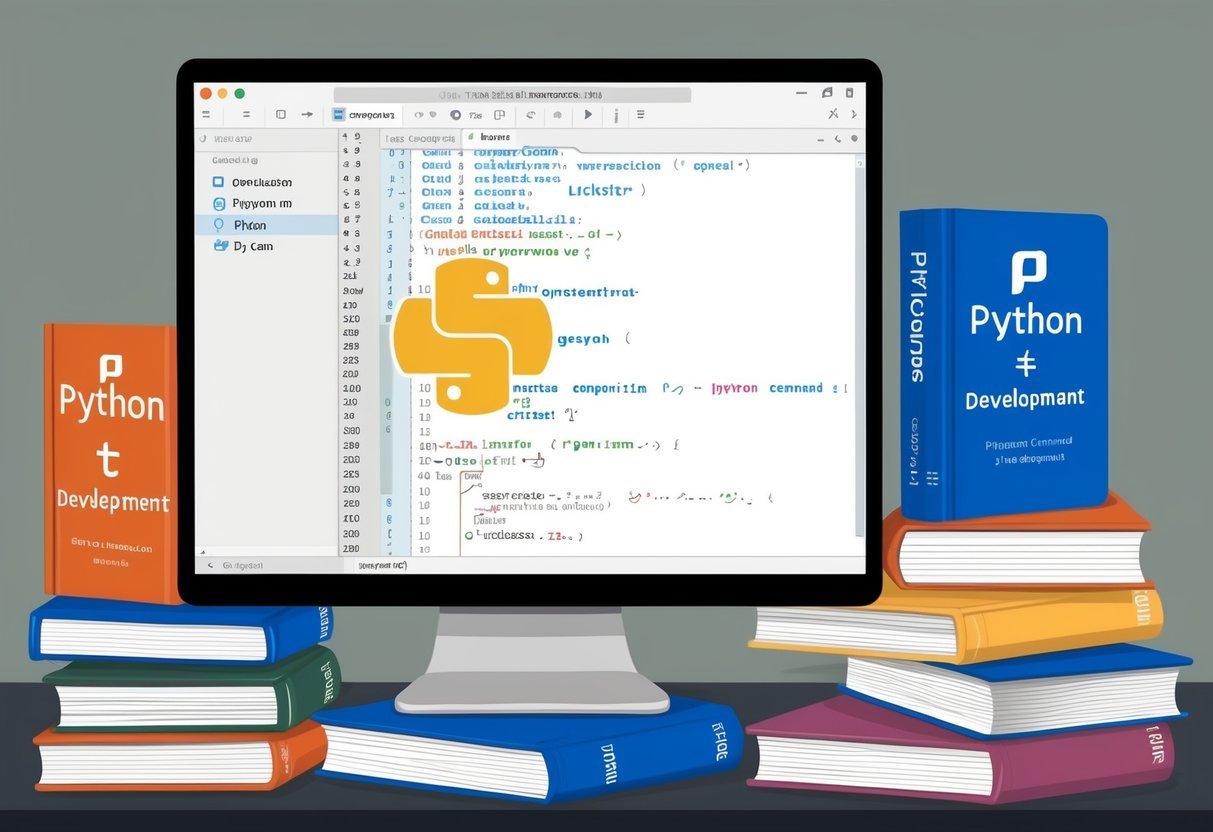Understanding the Basics of OOP
Object-oriented programming (OOP) is a powerful methodology used in languages like Java, Python, and C++. It focuses on real-world entities, allowing for efficient code organization through concepts such as encapsulation and inheritance.
Mastering these basics is essential for developing robust and scalable software.
Introduction to Object-Oriented Programming
Object-oriented programming is a paradigm centered around “objects” and “classes.” Classes are blueprints defining properties and behaviors for objects. An object is an instance of a class, containing data and methods that perform actions.
This model closely mirrors real-life objects, making it intuitive for developers to manage complex applications.
OOP emphasizes data encapsulation, where an object’s internal details are hidden. This approach helps protect data integrity and promotes modular code. It also allows for better maintenance and clearer interfaces.
Languages like Java, Python, and C++ widely use OOP principles. Each of these languages implements these concepts in its unique way, providing flexibility in how programmers solve problems.
Core OOP Concepts
Understanding core OOP concepts is essential for developing effective software. Encapsulation involves placing an object’s data and methods in a single unit, preventing unauthorized access to information.
Inheritance allows a new class to derive properties from an existing one, promoting reusability and reducing redundancy. This is a central tenet in languages like Java.
Abstraction simplifies complex processes by exposing only necessary parts of an object, promoting code clarity.
Polymorphism lets objects be treated as instances of their parent class, allowing methods to be redefined. This concept is crucial in OOP, as it provides flexibility in code implementation.
Each of these principles effectively helps manage complex code bases and aids in building scalable applications across various programming languages.
Inheritance in OOP
Inheritance is a key feature of object-oriented programming (OOP), allowing a new class to inherit properties and methods from an existing class. By leveraging this concept, programmers can write efficient and maintainable code.
This section explores how inheritance works, the various types, and the significance of superclasses and subclasses.
Defining Inheritance
Inheritance in OOP refers to the mechanism where a new class, known as the subclass or derived class, inherits attributes and behaviors (methods) from another class called the superclass or parent class. This concept allows developers to create a hierarchy where common functionality is shared, promoting code reuse and reducing duplication.
For example, in Java or C++, a base class Animal may have subclasses like Dog and Cat, each inheriting common traits. Similarly, in Python, the syntax enables seamless inheritance by simply passing the superclass name within parentheses.
Understanding inheritance is crucial for grasping the structure and design of class-based systems, enabling streamlined development processes.
Types of Inheritance
There are several types of inheritance in OOP:
- Single Inheritance: A subclass inherits from one superclass, common in languages like Java.
- Multiple Inheritance: A subclass inherits from multiple superclasses, supported in Python but not directly in Java. C++ also supports this feature.
- Multilevel Inheritance: A class inherits from a superclass, which itself is a subclass of another class.
- Hierarchical Inheritance: Multiple subclasses inherit from a single superclass, sharing its features.
Each type serves distinct purposes and fits different scenarios, providing flexibility in code architecture. Understanding these types helps developers choose the best structure for their applications.
The Role of Superclass and Subclass
The superclass is the foundation, defining common traits and behaviors for subclasses. It sets the attributes and methods that can be inherited, ensuring consistent behavior across different subclasses.
Subclasses provide specialization. They inherit all the features of the superclass but can also add or modify behaviors.
This relationship allows for an organized codebase where changes to the superclass automatically propagate to subclasses, simplifying maintenance and enhancing code quality.
Polymorphism and Reusability
Polymorphism allows objects to be treated as instances of their parent class, while code reusability helps developers avoid redundancy. Both concepts enhance efficiency in object-oriented programming.
Understanding Polymorphism
Polymorphism in programming refers to methods that can do different things based on the object they are acting upon. One way to achieve this is by method overriding. This is when a subclass provides a specific implementation for a method already defined in its superclass.
Another approach is method overloading, where multiple methods have the same name but differ in the type or number of their parameters. This allows a single method to handle different inputs, adjusting its behavior accordingly.
The flexibility that polymorphism offers makes programs easier to build and alter, aligning them with varying needs.
Achieving Code Reusability
Code reusability in object-oriented programming reduces redundancy and simplifies program maintenance. It is primarily achieved through inheritance, allowing a subclass to inherit fields and methods from its superclass.
This means shared functionality only needs to be written once, reducing the likelihood of errors and saving development time.
Besides inheritance, method overriding plays a significant role in reusability. It enables subclasses to customize what they inherit to better fit their purpose.
Through inheritance and polymorphic techniques, developers create robust code structures that can be easily adapted to expanding needs. This approach is a vital aspect of reducing redundancy and fostering efficient coding practices, as seen in flexible OOP methods.
Encapsulation and Data Security

Encapsulation is a key concept in object-oriented programming that enhances data security by controlling how data is accessed and modified. It is achieved through the use of classes and access modifiers, which help in safeguarding sensitive information and maintaining the integrity of code.
Encapsulating Data
Encapsulation involves wrapping data and the methods that manipulate it within a single unit called a class. This technique restricts direct access to some components of an object and can prevent unauthorized interference and misuse.
By defining properties and functions within a class, encapsulation allows a class to control its internal state more securely.
Developers use encapsulation to hide the details of an implementation and expose only what is necessary. This not only simplifies the interface of the class but also reduces complexity and increases security.
By separating concerns, encapsulation makes it easier to manage changes in the codebase, as changes to hidden parts of the class do not affect other parts of the program.
Access Modifiers and Their Role
Access modifiers are keywords used in programming to set the access level for classes, variables, and methods. They play a crucial role in implementing encapsulation and enhancing data security.
Common access modifiers include private, protected, and public.
- Private: Restricts access to members of a class from code outside the class.
- Protected: Allows access within its class and by derived class instances.
- Public: Grants access to any other code.
By using these modifiers, programmers can control which parts of the code can interact with the data. For example, marking a variable as private ensures that it can only be modified through public methods.
This adds a layer of validation and control, protecting the data integrity within the application.
Design Patterns and Best Practices
In object-oriented programming, adopting effective design patterns and best practices is crucial. These approaches ensure software is scalable and maintainable. When implemented properly, they enhance code quality and structure.
Applying SOLID Principles
The SOLID principles are a foundation for designing robust software systems. They include Single Responsibility Principle, which ensures a class has one job. This reduces code complexity and makes maintenance simpler.
Open/Closed Principle advocates for systems being open to extension but closed to modification. This prevents altering existing code when adding new features, reducing bugs.
The Liskov Substitution Principle requires that subclasses should be replaceable with their parent classes. Violation of this can lead to system errors.
Interface Segregation Principle emphasizes creating specific interfaces rather than one general interface.
Dependency Inversion Principle suggests that higher-level modules should not depend on lower-level ones, but both should depend on abstractions.
Common Design Patterns
Design patterns offer solutions to common problems in software design. The Decorator Pattern is used to extend the functionality of objects without altering their structure. It’s ideal when using inheritance isn’t suitable.
Composition over Inheritance prefers composition because it offers greater flexibility and avoids the complexities of deep inheritance hierarchies. This leads to more modular and reusable code.
Patterns like the Singleton ensure that a class has only one instance, which is perfect for scenarios where a single point of control is necessary.
These patterns offer time-tested solutions, enabling developers to create behaviorally rich yet concise systems robustly. For more insights on design patterns, visit this comprehensive guide.
Programming Language-Specific OOP
Understanding how different programming languages implement object-oriented programming (OOP) can enhance a developer’s ability to utilize inheritance and other key concepts effectively. This section looks into specific features and idioms of OOP as used in Java, Python, and C++.
Java OOP Features
Java is well known for its robust OOP features. The language emphasizes encapsulation, inheritance, and polymorphism with a clear structure.
Inheritance in Java is achieved through extending classes, allowing a subclass to inherit fields and methods from the superclass. Interfaces in Java allow multiple inheritance of types, a feature not supported by classes in Java.
Java’s syntax supports creating abstract classes and methods, letting developers define methods without implementation for subclasses to implement. Java OOP features create a clean design and promote reusability of code.
Python’s Approach to OOP
Python uses a sophisticated but flexible approach to OOP, making it easier to learn. In Python, classes can be created quickly and new objects instantiated with minimal syntax.
Python supports multiple inheritance allowing a class to be derived from more than one superclass, making it unique in managing complex hierarchies.
Thanks to Python’s dynamic typing, attributes can be added or modified at runtime. This adds flexibility but requires careful management to avoid unintended errors.
Python’s simple syntax provides a smooth OOP learning curve, attracting beginners to programming.
C++ OOP Idioms
C++ offers powerful OOP features, balancing control and complexity. It includes traditional OOP concepts like classes, inheritance, and polymorphism.
In C++, multiple inheritance is directly supported, unlike Java, which complicates the development process but enriches functionality.
C++ also introduces concepts such as templates and operator overloading, which extend the OOP paradigm further. This provides advanced ways to manipulate data and objects but demands a deep understanding of the C++ OOP idioms for efficient use. C++’s strong emphasis on control makes it favored in systems programming and game development.
Constructors and Destructors
In object-oriented programming, constructors and destructors handle the creation and destruction of objects. This section covers their importance, how they work in different programming languages like Java and C++, and special types like the copy constructor.
Understanding Constructors
Constructors are special functions used to initialize objects when a class is instantiated. They share the same name as their class and do not return any value.
In C++, constructors can be default, parameterized, or copy constructors. The copy constructor duplicates an existing object’s state into a new one.
In Java, constructors play a similar role, ensuring objects start with a consistent state. Unlike C++, Java does not support copy constructors directly but can mimic similar functionality using other methods.
Java constructors can be overloaded, allowing multiple versions for different initialization scenarios.
The Role of Destructors
Destructors are crucial for resource management, particularly in languages like C++ where manual memory management is common. A destructor is called automatically when an object is no longer needed, ensuring that resources, such as memory, are freed correctly.
In C++, destructors have the same name as the class, prefixed with a tilde (~).
Java, however, does not use destructors. Instead, it relies on its garbage collector to manage memory automatically. When objects are no longer reachable, the garbage collector reclaims their memory, eliminating the need for explicit destructors.
This process simplifies memory management but may result in less control over the exact timing of resource release.
Special Constructors in Java and C++
Special constructors offer unique functionalities within Java and C++.
In C++, a copy constructor creates a new object as a copy of an existing one. This is important when objects dynamically allocate memory, as shallow copying might lead to issues.
Java does not have built-in copy constructors but often uses a prototype pattern or cloning.
C++ also supports move constructors, which optimize the transfer of resources from one object to another without unnecessary copying.
Both languages use assignment operators to assign values from one object to another, but C++ provides flexibility for overloading this operator to fit specific needs.
Exception Handling and Safety
Exception handling in programming languages like Python and Java is crucial for building robust applications. Understanding how to properly handle exceptions ensures that unexpected errors don’t crash the entire system. It’s important to use these techniques to maintain program flow and data integrity.
Basics of Exception Handling
In many programming languages, exception handling allows developers to manage errors gracefully.
Python uses try, except, and finally blocks to manage exceptions. In Python, the try block lets the program test a block of code for errors, while the except block handles them. The finally block runs code, whether errors occur or not.
Java uses try, catch, finally, and throw to handle exceptions. The try block identifies code for potential exceptions, and the catch block manages those exceptions.
C++ offers similar structures, allowing developers to catch and manage exceptions effectively. Understanding these basic techniques is essential for writing safe and reliable code.
Custom Exception Classes
Custom exception classes allow developers to define their error types, making it easier to handle unique errors relevant to specific applications.
In Python, a custom exception can be created by subclassing the built-in Exception class. This approach makes error messages more descriptive and programs easier to debug.
Java allows creating custom exceptions by extending the Exception class. This custom approach is beneficial when the standard set of exceptions doesn’t fit the specific error scenario.
C++ provides flexibility through its hierarchical exception class system, enabling developers to introduce custom exception handlers tailored to their application’s needs.
Applications of OOP
Object-Oriented Programming (OOP) is widely used in various fields due to its capacity to create organized and maintainable code. It plays a significant role in game development, enterprise software, and web development, offering a robust framework for building scalable systems.
Game Development Using OOP
In game development, OOP is fundamental. It allows developers to model game entities as objects, each with specific attributes and methods.
For example, a character in a game can be an object with properties like health, speed, and strength, and methods to move or attack. This approach promotes code reusability and ease of maintenance.
Games often require complex interactions between objects, such as characters, weapons, and environments. OOP helps manage these interactions efficiently by keeping code modular and easy to update.
This modularity is essential for large teams working on different parts of a game simultaneously, facilitating collaboration and version control.
Enterprise Software and OOP
Enterprise software relies heavily on OOP because it supports building complex systems that can handle large amounts of data and transactions. OOP enables the creation of classes that can be reused and adapted, saving time and reducing errors.
This is crucial for business applications that require continuous updates and scalability.
For instance, in a customer relationship management system, different classes might represent customers, leads, and sales teams. These classes can interact seamlessly, allowing for efficient data management and reporting.
OOP ensures that software can grow with the business, accommodating new features and changes in a controlled manner.
OOP in Web Development
OOP has a strong presence in web development, especially with the rise of frameworks that utilize object-oriented principles. Languages like JavaScript, Python, and Ruby use OOP to create dynamic and responsive web applications.
Developers can model elements like users, sessions, and data entries as objects, leading to a more intuitive code structure.
Using OOP in web development helps manage the complexity of applications by organizing code into objects and classes. This structure allows for easier testing and debugging, which enhances reliability and security.
As web applications become more complex, OOP provides the tools needed to manage growth and change efficiently.
Advanced OOP Concepts
Advanced object-oriented programming (OOP) concepts provide a deeper understanding of programming by exploring dynamic behaviors and efficient memory usage. These concepts enhance code flexibility and performance, making them essential for effective software development.
Runtime Polymorphism and Dynamic Binding
Runtime polymorphism allows objects to be treated as instances of their parent class, while the specific method implementation is chosen at runtime. This is achieved through dynamic binding, which defers method resolution until runtime. This feature supports flexibility in code design as methods can be overridden in subclasses.
Dynamic binding improves code maintenance by allowing changes to subclass methods without altering the parent class. It also benefits from interfaces in languages like Java, where different classes implement the same interface, allowing for seamless method invocation.
This results in more robust and adaptable software systems.
Memory Management in OOP
Effective memory management is crucial in OOP to ensure efficient application performance.
Garbage collection is a key feature in languages like Java and Python, where the system automatically reclaims memory by removing objects no longer in use. This reduces the risk of memory leaks.
Manual memory management is common in languages like C++, where programmers allocate and deallocate memory using keywords like new and delete.
Understanding memory allocation, stack vs. heap memory, and object lifetime is important for optimizing resource use and application performance.
Well-managed memory is essential for avoiding issues like fragmentation and ensuring system stability.
Building Maintainable and Modular Code
Object-oriented programming (OOP) helps create software that is both maintainable and modular. Key strategies include using clear code structures and embracing modular design. Maintaining clean code is vital for efficiency.
Strategies for Writing Maintainable Code
Writing maintainable code in OOP involves several key strategies. Developers should prioritize clear naming conventions for variables and functions, making the code self-explanatory.
Comments and documentation are also critical, as they help future developers understand the codebase quickly.
Unit testing plays a crucial role in maintainability. These tests, often automated, catch bugs early and ensure changes do not break the existing functionality.
Consistent testing makes it easier to expand or refactor code without introducing new issues.
Following design patterns can further enhance maintainability. Patterns like the Model-View-Controller (MVC) offer a structured approach for complex applications, ensuring that parts of the code remain independent but well-coordinated.
Modularity in OOP
Modularity is a cornerstone of effective OOP. It breaks down complex software systems into smaller, manageable pieces or modules. Each module focuses on a specific functionality, enhancing reusability and reducing redundancy.
In OOP, encapsulation is essential for achieving modularity. This principle ensures that data and methods relevant to an object are bundled together.
This packaging allows developers to isolate changes to specific parts without affecting the entire system.
Applying inheritance supports modular designs by allowing new classes to adopt properties and behaviors from existing ones. This feature makes code extensions straightforward and ensures that changes to base classes automatically propagate to derived classes, maintaining consistency across the application.
Resources and Tools for Learning OOP
When learning object-oriented programming (OOP), leveraging the right resources can greatly enhance understanding and application. The following tools provide various means to explore OOP concepts effectively.
Online Learning Platforms
Online platforms are valuable for guided learning and interactive exercises. Platforms like Codecademy and Coursera offer courses in OOP using languages like Java. These courses introduce key concepts such as classes, inheritance, and polymorphism, often with hands-on projects.
YouTube is another essential tool. Numerous YouTube channels feature tutorials that break down complex OOP concepts into digestible segments, enhancing comprehension through visual learning. These platforms cater to various learning styles, making them indispensable for anyone eager to learn to code.
OOP in Open Source Curriculum
Open source projects offer practical exposure to OOP. GitHub is a hub for these projects, allowing learners to engage in real-world scenarios.
By studying or contributing to these repositories, one gains insight into best practices and innovative solutions in OOP.
Many open source curricula incorporate popular tools like the Java Development Kit (JDK) and IntelliJ IDEA. These tools are crucial in implementing OOP principles effectively.
Such curriculums often emphasize hands-on learning, enabling learners to build projects that reinforce theoretical knowledge and develop problem-solving skills in a collaborative environment.
Frequently Asked Questions
Learning inheritance in object-oriented programming (OOP) involves understanding various concepts and applying them to practical situations. These questions address strategies, real-world applications, and key principles central to mastering OOP inheritance.
What are some effective strategies for practicing OOP inheritance in Java?
To effectively practice OOP inheritance in Java, learners should start by identifying common patterns in programming tasks.
Building small projects that use parent and child class relationships helps solidify understanding. Utilizing platforms with coding challenges like GeeksforGeeks can further enhance practice by providing structured problems and solutions.
Can you give a practical example of inheritance in OOP applied to a real-world scenario?
In a real-world scenario, consider a vehicle simulation. A base class Vehicle might include methods common to all vehicles, such as start and stop. Derived classes like Car and Truck inherit from Vehicle and add specific features. This mirrors OOP principles of reusability and scalability.
Which exercises can help to reinforce the concept of polymorphism in object-oriented programming?
To reinforce polymorphism, exercises involving method overriding and interfaces should be practiced. These tasks can include designing a payment processing system with generic methods that are overridden in classes like CreditCardPayment and PayPalPayment.
Exercises on sites like Flexiple offer valuable practice scenarios.
What are the four pillars of object-oriented programming and how do they relate to inheritance?
The four pillars of OOP are encapsulation, abstraction, inheritance, and polymorphism. Inheritance allows a new class to take on properties of an existing class, promoting code reuse.
Learning about inheritance in Java often involves understanding how these pillars support creating well-structured, modular code.
How much time should a beginner allocate to become proficient in object-oriented programming principles?
A dedicated beginner might spend several months learning OOP principles, setting aside 5 to 10 hours per week for consistent practice. Building projects gradually increases proficiency.
Resources like InterviewBit provide structured learning paths that guide beginners through comprehensive OOP topics.
What are the best resources or practices for beginners to learn about encapsulation in OOP?
For encapsulation, tutorials, textbooks, and online courses serve as valuable resources.
Books like “Clean Code” and interactive platforms such as Codecademy offer practical exercises on data hiding and interface implementation.
Regular practice through coding challenges can further reinforce these concepts in real-world scenarios.













